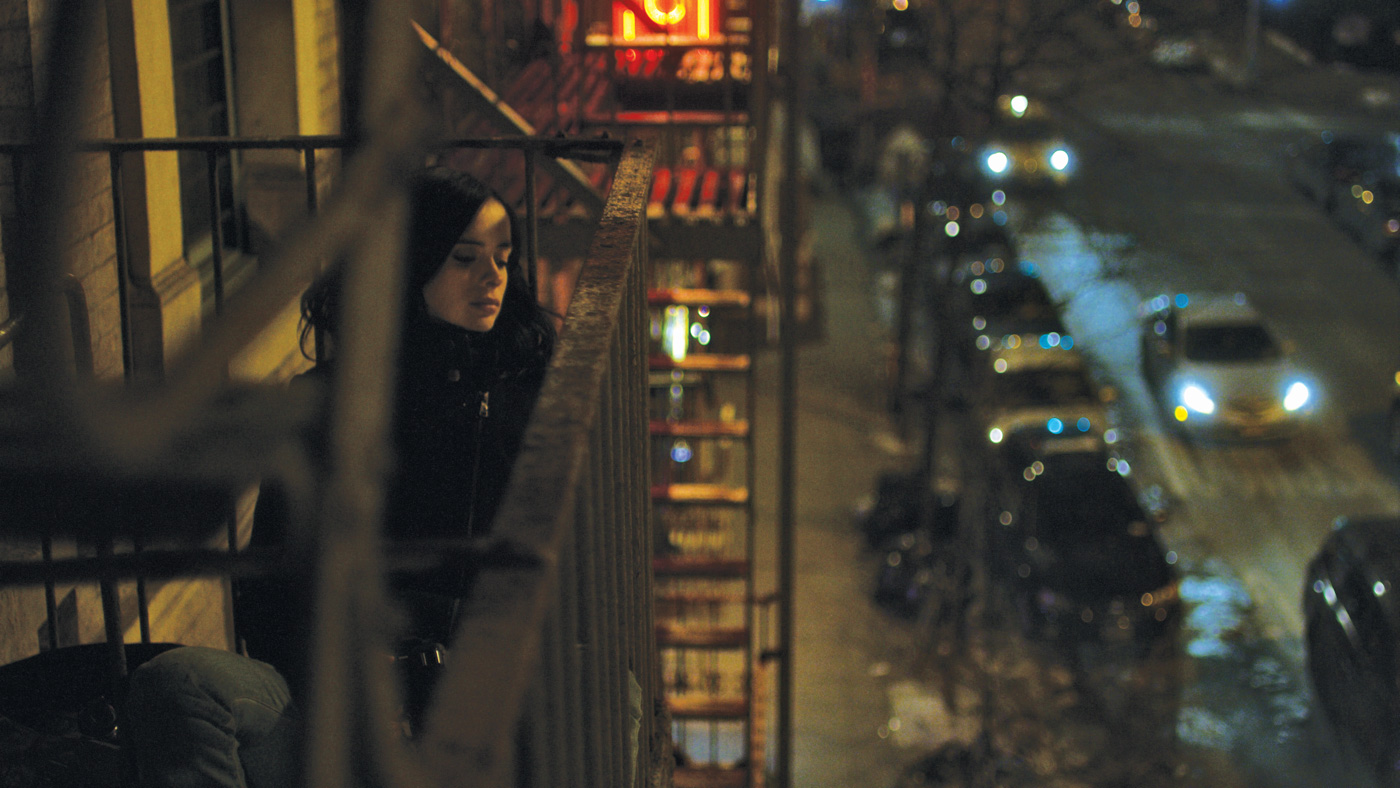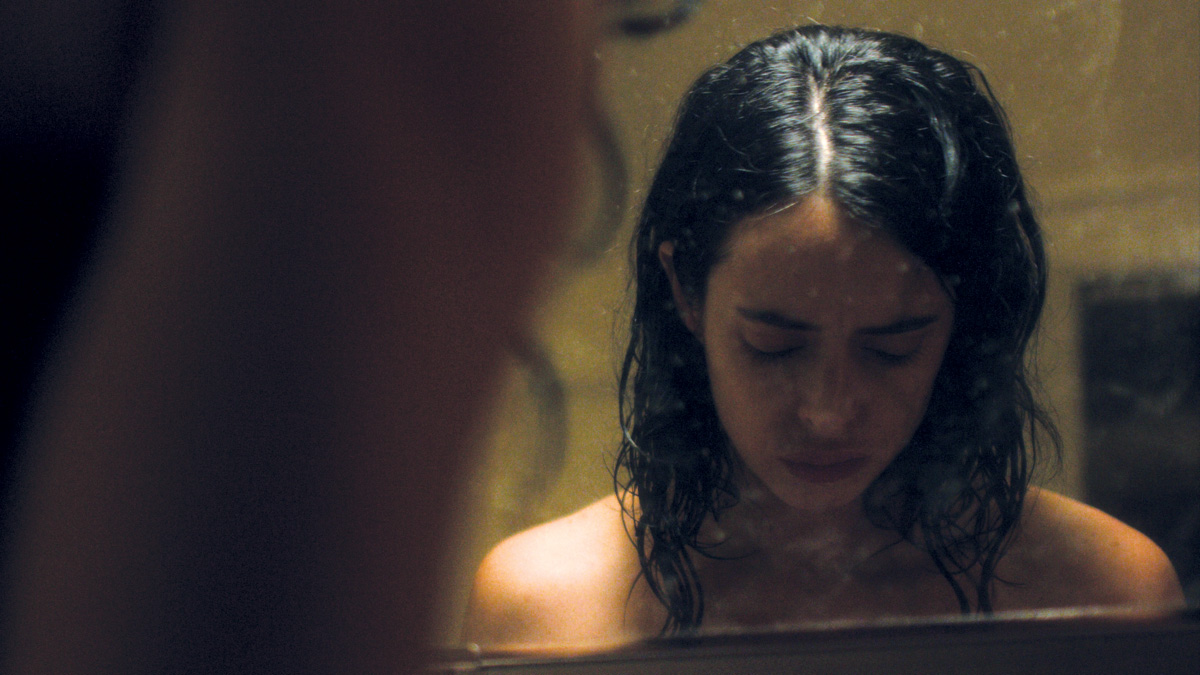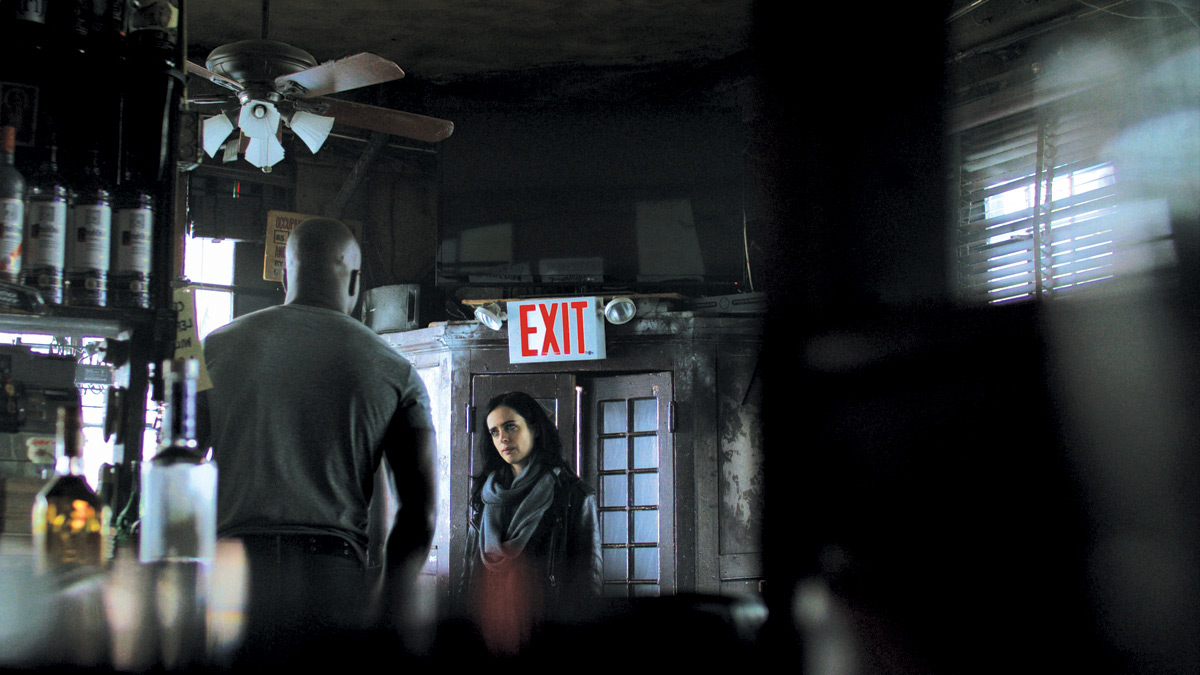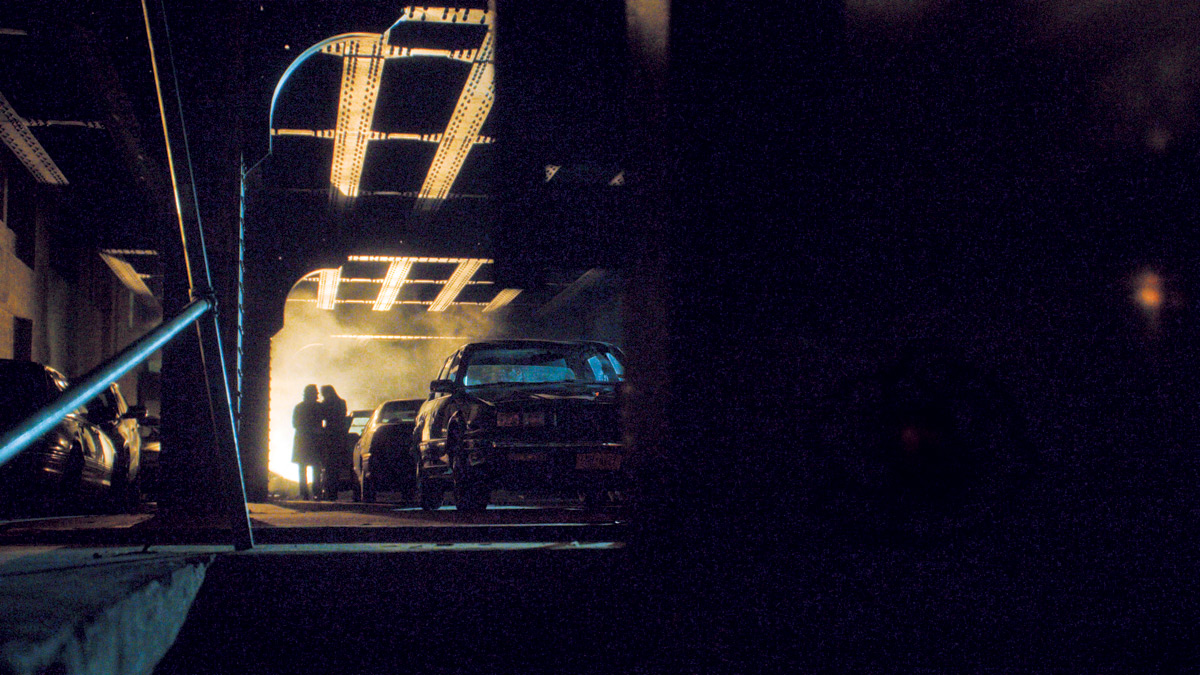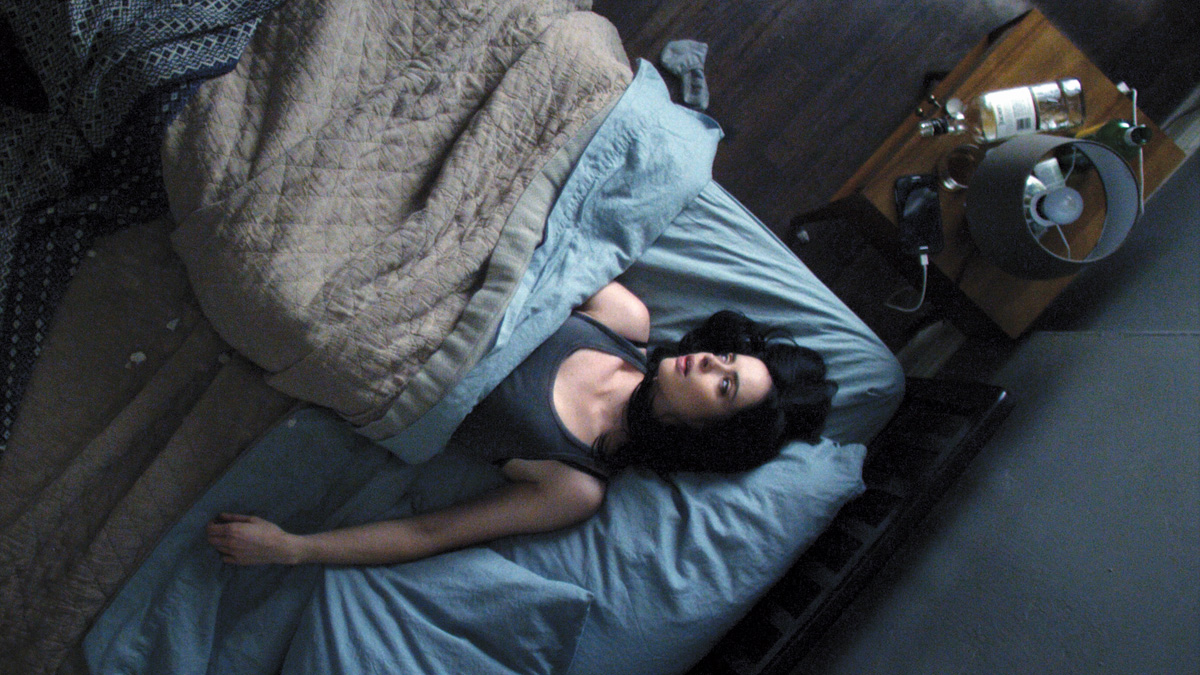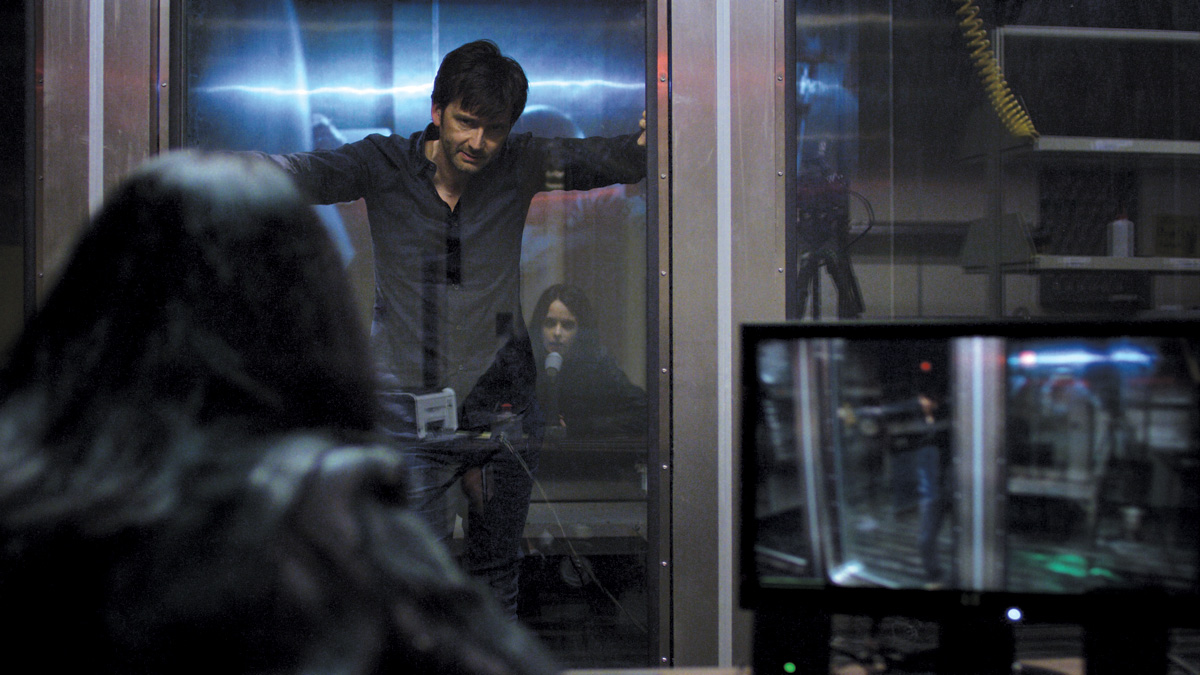Jessica Jones is a new kind of Marvel superhero for the digital age – flawed, funny, female and streaming!
Marvel’s new streaming Netflix series, Jessica Jones, is a modern noir: there’s a hard-boiled PI with a criminal past and a cynical dame who drinks cheap bourbon. The twist here is that the lead character is all of the above – and she is also a former superhero. Jessica Jones (Krysten Ritter) would rather forget that part of her past – but she can’t, because she has insomnia, nightmare flashbacks, and post-traumatic stress disorder from her evil former lover The Purple Man, aka Dr. Zebediah Kilgrave (David Tennant). And anyway, a broad needs to make a living.
The series, which is lensed by Manuel Billeter (Person of Interest and Law & Order) opens at night in the grimy Hell’s Kitchen neighborhood of Manhattan. Jones is on a stakeout, waiting in the shadows to catch an adulterous couple. We hear her in voiceover, which sets the world-weary yet darkly comedic tone of the series: “New York may be the city that never sleeps,” she cracks, “but it sure as hell sleeps around.”
Jessica Jones is certainly not your typical Marvel comic book adaptation. Just ask Marvel Head of Television Jeph Loeb (Smallville, Lost and Heroes), an award-winning comic book writer whose credits include Spider-Man, Batman, Superman, Hulk and Iron Man. Way back in 2002, Loeb wrote the foreword for the Alias collection, the original comic series (created by Brian Michael Bendis) that introduced the hard-bitten female lead. “Jessica’s world isn’t pretty,” Loeb explains in that introduction. “There are no capes here. No secret headquarters. Just the underbelly of the Marvel universe cut open for all of us to be amazed by.”
Loeb goes on to provide some context for the rise of that Marvel universe.
“Back then [in 2002], comics were seen as just geek food or adolescent male fantasies, and you were widely suspected to live in your mom’s basement if you read them,” he adds. “However, those of us who were into comics knew the secret. They were heartfelt stories, grounded in reality, with an element of the fantastic – hyperdrama at an elevated level. Then Spider-Man came along. It had a real director, a real star, and became one of the most successful films of all time. [Suddenly] the genre was taken seriously.” So seriously, in fact, that Marvel put out Alias on its MAX R-rated imprint, because it was not safe for after-school reading. This was exactly what Jessica Jones’ showrunner Melissa Rosenberg [see Exposure, page 34], who wrote on Dexter (Showtime) and was screenwriter on all five Twilight movies, was looking for in creating a female superhero.
“The idea of someone who had lived in a hyper-real world, like Twilight, with a strong female character, was attractive to us,” Loeb points out. “Plus, quite frankly, we wanted to get into the Melissa Rosenberg business.” Loeb sent Rosenberg the Alias collection, and she was hooked. “I was blown away by the writing, by the character of Jessica Jones. I just knew: this is the project I’d been waiting for,” Rosenberg recalls.
Marvel partner ABC ended up passing on the pitch due to the explicit content and dark themes. Enter Netflix, no stranger to dark material with sexual undercurrents, and a network that has changed the face of televised content through binge viewing. Netflix knew Marvel’s built-in comic and movie fan base would cross over for the right properties. So they bought it: 13 hours per series of each of the street-level heroes, including Jessica Jones, with The Defenders as an ensemble to follow at a later date.
In his first pitch meeting, Billeter used stills from photographer Saul Leiter, along with the trailer from Wong Kar-Wai’s 2046. But Billeter wasn’t weaned on Marvel. “My comics were mostly Italian,” he says. “Topolino, Diabolik, and later the work of Guido Crepax.” The DP grew up in Switzerland and lived in Berlin for nine years before moving to Manhattan. He drew on his experiences in the city when the Berlin Wall still divided its people, and he found echoes of its bruised decadence in Jessica Jones.
“When I first read the script, the tune of Lili Marleen came up in my head, the voice of Marlene Dietrich – in her low and throaty contralto, limited but yearning, vulnerable yet powerful. When I met with [director/executive producer] S.J. Clarkson for the first time, we had instant visual alignment. A cinematographer and a director have to get inside each other’s heads.”
The British-based Clarkson, who directed the first two episodes, works regularly on both sides of the Atlantic with U.S. credits including Orange Is The New Black, Heroes, and Dexter. Most recently she directed an episode of Martin Scorsese and Mick Jagger’s new series Vinyl (HBO) and is currently finishing up Love, Nina for the BBC.
As soon as Clarkson read the script for Jessica Jones, she put together a pitch doc with references ranging from The Third Man (1949) to Touch of Evil (1958), Taxi Driver (1976), Chinatown (1974) and Seven (1995).
“I could picture it instantly. The pace was perfect for noir,” she explained via phone from London. “It’s a great character-led piece, and a great female character at that: damaged but strong, not a victim, but not a bunny-boiler either. I knew I wanted to do this next. I flew to NYC and talked through my vision with Melissa Rosenberg, Cindy Holland from Netflix, Jeph Loeb and Jim Chory [with whom she’d previously worked on Heroes], both from Marvel. We all clicked.”
Netflix requires all of its content to be native 4K capture, so Billeter chose the RED DRAGON. To take the edge of all that ultra-resolution, he chose Panavision’s PVintage lenses, rehoused with glass from Ultra Speeds.
“They’re not as flawless, sharp or flat as newer lenses,” Billeter points out, “so they helped me tell the gritty noir story with more poetic realism. I had to be careful not to shoot too wide open, as otherwise they get too soft. I mostly shot them at T2, and at a deeper stop on the rare occasions that we went longer than 35 millimeter.”
A-camera 1st AC Josh Blakeslee, (who is now working as Billeter’s B- camera operator on Luke Cage), says they pushed the gear to get the effect they needed. “Netflix’s 4K standard means the Dragons have become their camera of choice,” he adds. “Periodically we would jump to 5K for certain VFX work, or to give space for reframing or stabilizing the image. The [ultrahigh resolution of the] Red was handy for those situations, as well.”
Billeter used DragonColor and REDgamma4 as the base camera setting, which produced a contrasty look. “I could display images on the monitors at video village that came close to my desires,” he describes. “Treating the single LUT like a film stock has its advantages – you get less fussy about grading on set and concentrate on getting the lighting ratios and colors right, and working with the director untethered. I would grade frame grabs of every set-up so the lab could match the dailies to my suggestions. The grading process in the truck also became a moment to review the day with my great camera crew (which included A-camera operators Mike O’Shea and Oliver Cary, A-camera 1st AC Josh Blakeslee, A-camera 2nd AC Andy Peck, B-camera operator Hernan Otano, B-camera 1st AC Marc Hillygus, B-camera 2nd AC Jason Rihaly, Loaders Amber Barrera, Vince Tuths, and 2nd Unit DP Bill Klayer).”
The Jessica Jones team wanted a “dark intensity” to let viewers into the character’s fractured psychological state of mind. This affected everything from lighting to screen composition. Or, as Clarkson explains: “You only see what Jessica wants to show you, so we used that in the look and feel of the show – lots of negative space, reflections, partial frames.
“The dark look of NYC in winter made me think of Nordic Noir, the crime novels and TV coming out of Scandinavia,” she continues. “Often we were shooting in three feet of snow, so it fit! [Manuel] stripped out primary colors, and I engaged with purple, a shade I rarely use as a filmmaker, but I wanted to be true to Kilgrave [who was, as noted, The Purple Man in the Marvel comic]. We had to feel Jessica’s inner turmoil.”
To add to the hyperrealism, Billeter wanted hard ceilings on every set to accentuate camera angles. For example, there are several shots of Jessica passed out on her bed from a hard night’s drinking. The lighting is cold, all steel grays and blues, and the ceiling in shot gives a claustrophobic feel, albeit creating lighting challenges of its own.
Billeter says that his gaffer, Tom Landi, brought in small and compact LED lights from Cineo, “and we used them to create book lights. But we were also able to use the smaller ones hiding in tight spaces. We had custom-made honeycomb grids [also used with Spider Lights and Kino Flos], which we applied straight onto the source to give them a very narrow focus. They save a lot of time because they make the setting of a lot of flags superfluous, plus their footprint is small. On a TV series, when you have just nine days to shoot sixty minutes of content, you need as many time-savers as you can get.”
Production Designer Loren Weeks brought a photography book, The Transparent City, by Michael Wolf, to his first meetings with Clarkson. “The book is mostly photos of people observed but from a distance, and the edifices of multi-storied buildings, very anonymous,” Weeks explains. “S.J. and I talked a lot about designing shots employing a frame within a frame, that idea of observing from a distance, of being emotionally removed from what you are observing.”
Weeks is also the production designer on Daredevil, another of Marvel’s street-level heroes for Netflix. Several of the characters – and locations – cross over from series to series. “Marvel’s Hell’s Kitchen is dark and gritty and was influenced by movies such as The French Connection and similar movies from that period,” Weeks adds. “Brutal but also visually beautiful.”
Jessica Jones has a temporary life. She eats cold pizza for supper with her scuffed boots up on the torn couch – furniture that you’d find tossed out on the street. Her office is just a spare room in the back of the apartment, with a view of the smashed glass pane in the front door. It stays smashed, which tells us this is a character who doesn’t really care and, when it comes down to it, can defend herself anyway, no barricade needed. She has superhero strength, after all, and can stop a car. She can fly. She’s a reluctant superhero, but a deeply, darkly brilliant female anti-hero.
Rosenberg says Ritter was always high on her casting list to play the complex leading role. “My husband [Lev L. Spiro] had directed [Ritter] in Don’t Trust The B— in Apartment 23 and had spoken very highly of her, both as an actress and a person,” she recalls. “When the project came over to Netflix, she was one of the first actresses we saw. This a woman who can deliver a dry comedic line, then turn on a dime to dive into the searing dark side of drama. She’s incredibly agile.”
Once Ritter was in place, other great names joined the cast, including Tennant, best known as Doctor Who; Mike Colter as fellow street-level hero Luke Cage; and Carrie-Anne Moss, from The Matrix, as Hogarth. It’s a nice example of gender-blind casting. Hogarth was the name of a male character in the original comic, but, without going into plot-spoiler details, the sharp-suited attorney is still having love-life dramas with dames.
Rosenberg describes Jessica Jones as damaged, deeply flawed and, at times, “a hard person to love. She can be mean, makes huge mistakes, and is sometimes unforgivable,” the three-time Emmy nominee says with pure candor. “But that sort of complicated hero has been the realm of the white male lead, until now. TV is changing that picture, putting women front and center.”
Nothing typifies that kind of change more than some of the cutting dialogue Jones spews out. Like when a character berates her for being cold and cruel, saying, “You use sarcasm to distance people,” Jessica’s response is: “And yet you’re still here.”
Billeter was drawn to the project because it was unlike anything he’d seen before. “It intrigued me that she is an ex-superhero that suffers from PTSD. I thought that was clever; you don’t expect a superhero to be suffering. Superheroes save the world, they always win. But, in Jessica Jones, the starting point was failure, if you will, a narrative that delves back into the past, a twisted former relationship, and her self-destructive behavior. I wanted to follow her on this journey. I could see it unfolding; I could picture it.”
A Barbara Stanwyck for this new binge-watching generation? Only time will tell.
by SOPHIA STUART / photos courtesy of Marvel/Netflix

